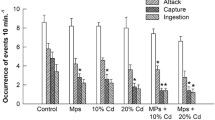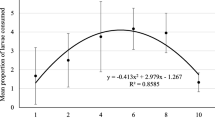Abstract
Population growth and life table demography of the predatory rotifer A. girodi using spineless Brachionus calyciflorus and spined Brachionus havanaensis as prey at densities of 1, 2, 4 and 8 ind. ml−1 at 25 °C were studied. Regardless of the prey species, the population of A. girodi increased with increasing availability of Brachionus in the medium. At any given prey density, A. girodi fed B. calyciflorus showed consistently better growth than when fed B. havanaensis. The maximum population densities of A. girodi varied from 0.28 to 1.8 ind. ml−1 depending on the prey species and the density. The rate of population increase observed in population growth studies varied from 0.17 to 0.43 day−1 when fed B. calyciflorus and 0.09 to 0.27 day−1 when fed B. havanaensis. Male population of A. girodi was closely related to female density. The lowest average lifespan was observed for A. girodi when fed B. havanaensis at 1 ind. ml−1, while the converse was the case when fed B. calyciflorus at comparable prey concentration. Net reproductive rates varied from 16 to 26 offspring female−1 lifespan−1 depending on the prey species and concentration. Generation time of A. girodi decreased with increasing food concentrations for both the prey species. The rates of population increase obtained from life table demography were lower for A. girodi when fed B. havanaensis than when fed B. calyciflorus.
Similar content being viewed by others
References
Allan, J. D., 1976. Life history patterns in zooplankton. Am. Nat. 110: 165-180.
Anonymous, 1985. Methods of measuring the acute toxicity of effluents to freshwat. and marine organisms. US Environment Protection Agency EPA/600/4-85/013.
Conde-Porcuna, J. M. & S. S. S. Sarma, 1995. Prey selection by Asplanchna girodi (Rotifera): The importance of prey defence mechanisms. Freshwat. Biol. 33: 341-348.
Dodson, S. I. & D. G. Frey, 2001. Cladocera and other Branchiopoda. In: Thorp, J. H.& Covich (eds), Ecology and Classification of North American Freshwater Invertebrates, Second Edition, Academic Press, San Diego: 848-913.
Dumont, H. J., 1977. Biotic factors in the population dynamics of rotifers. Arch. Hydrobiol. Beih. 8: 98-122.
Dumont, H. J., I. van de Velde & S. Dumont, 1976. The dry weight estimate of biomass in a selection of Cladocera, Copepoda and Rotifera from the plankton, periphyton and benthos of continental waters. Oecologia 19: 75-97.
Dumont, H. J., S. S. S. Sarma & A. J. Ali, 1995. Laboratory studies on the population dynamics of Anuraeopsis fissa (Rotifera) in relation to food density. Freshwat. Biol. 33: 39-46.
Dumont, H. J. & S. S. S. Sarma, 1995. Demography and population growth of Asplanchna girodi (Rotifera) as a function of prey (Anuraeopsis fissa) density. Hydrobiologia 306: 97-107.
Galindo, M. D., C. Guisande & J. Toja, 1993. Reproductiveinvestment of several rotifer species. Hydrobiologia 255/256: 317-324.
García-Varela, M., G. Pérez-Ponce de Léon, P. de la Torre, P. M. Cummings, S. S. S. Sarma & J. P. Laclette 2000. Phylogenetic relationships of Acanthocephala based on an analysis of 18s ribosomal RNA gene sequences. J. mol. Evol. 50: 532-540.
Gilbert, J. J., 1977. Selective cannibalism in the rotifer Asplanchna sieboldi. Arch. Hydrobiol. Beih. 8: 267-269.
Gilbert, J. J., 1980. Feeding in the rotifer Asplanchna: Behaviour, cannibalism, selectivity, prey defenses and impact on rotifer communities. In: Kerfoot, W. C. (ed.), Evolution and Ecology of Zooplankton Communities. Univ. Press of New England, Hanover, NH: 158-172.
Gilbert, J. J., 1983. Rotifera. In: Adiyodi, K. G. & R. G. Adiyodi (eds), Reproductive Biology of Invertebrates 1. Oogenesis, oviposition and oosorption. John Wiley, New York: 181-209.
Gilbert, J. J., 1999. Kairomone-induced morphological defenses in rotifers. In: Tollrian, R. & C. D. Harvell (eds), The Ecology and Evolution of Inducible Defenses. Princeton University Press, Princeton, NJ: 127-141.
Gilbert, J. J., 2001. Spine development in Brachionus quadridentatus from an Australian billabong: genetic variation and induction by Asplanchna. Hydrobiologia 446/447: 19-28.
Gilbert, J. J. & R. S. Stemberger, 1984. Asplanchna-induced polymorphism in the rotifer Keratella slacki. Limnol. Oceanogr. 29: 1309-1316.
Gillooly, J. F., 2000: Effect of body size and temperature on generation time in zooplankton. J. Plankton Res. 22: 241-251.
Gillooly, J. F., E. L. Charnov, G. B. West, V. M. Savage & J. H. Brown, 2002. Effects of size and temperature on developmental time. Nature 417: 70-73.
Green, J. & O. B. Lan, 1974. Asplanchna and the species Brachionus calyciflorus in two Javanese sewage ponds. Freshwat. Biol. 4: 223-226.
Guiset, A. 1977. Stomach contents in Asplanchna and Ploesoma. Arch. Hydrobiol. Beih. 8: 126-129.
Halbach, U. & G. Halbach-Keup, 1974. Quantitative beziehungen zwischen phytoplankton und der Populationsdynamik des rotators Brachionus calyciflorus Pallas. Befunde aus Laboratoriumsexperimentenund Freilanduntersuchungen. Arch. Hydrobiol. 73: 273-309.
Hofmann, W., 1985. Food selection of a predominantly phytophagous population of the plankton rotifer Asplanchna priodonta (Grosser Poenitzer See) (Eastern Holstein, West Germany). Faun.-Oekol. Mitt. 5: 365-373.
Hutchinson, G. E. 1967. A Treatise on Limnology. Introduction to the lake biology and the limnoplankton. Vol. 2, John Wiley & Sons, New York, 1115 pp.
Iyer, N. & T. R. Rao, 1995. The epizoic mode of life in Brachionus rubens Ehrenberg as a deterrent against predation by Asplanchna intermedia Hudson. Hydrobiologia 313-314: 377-380.
Iyer, N. & T. R. Rao, 1996. Responses of the predatory rotifer Asplanchnaintermedia to prey species differing in vulnerability: Laboratory and field studies. Freshwat. Biol. 36: 521-533.
Jia, F., Y. Zhou, S. Jin & L. Lu, 2002. Influence of salinity on survival, development, reproduction and intrinsic growth rate of Asplanchna brightwelli. J. Dalian Fish. Coll. 17: 37-41.
King, C. E., 1982. The evolution of lifespan. In: Dingle, H. & J. P. Hegmann (eds), Evolution and Genetics of Life Histories. Springer, New York: 121-128.
King, C. E. & T. W. Snell, 1980. Density dependent sexual reproduction in natural population of the rotifer Asplanchna girodi. Hydrobiologia 73: 149-152.
Koste, W., 1978. Rotatoria. Die Rädertiere Mitteleuropas. Ein Bestimmungswerk begründet von Max Voigt. Bornträger, Stuttgart, Vol. 1: Textband 673 pp., Vol. 2: Tafelband 234 pp.
Krebs, C. J., 1985. Ecology. The Experimental Analysis of Distribution and Abundance. Harper and Row, New York.
Kumar R. & T. R. Rao, 2001. Effect of the cyclopoid Mesocyclops thermocyclopoides on the interaction between the predatory rotifer Asplanchna intermedia and its prey Brachionus calyciflorus and B. angularis. Hydrobiologia 453/454: 261-268.
Lampert, W. & U. Sommer, 1997. Limnoecology: The Ecology of Lakes and Streams. Oxford University Press, New York.
Meyer, J. S., C. G. Ingersoll, L. L. McDonald & M. S. Boyce, 1986. Estimating uncertainty in population growth rates: Jackknife vs bootstrap techniques. Ecology 67: 1156-1166.
Nandini, S., 2000. Responses of rotifers and cladocerans to Microcystis aeruginosa (Cyanophyceae): A demographic study. Aquat. Ecol. 34: 227-242.
Nandini, S. & S. S. S. Sarma, 2002. Population growth of some genera of cladocerans (Cladocera) in relation to algal food (Chlorella vulgaris) levels. Hydrobiologia (Present volume).
Pourriot, R., 1974. Relations prédateur-proie chez les Rotife'res: influence du prédateur (Asplanchna brightwelli) sur la morphologie de la proie (Brachionus bidentata). Ann. Hydrobiol. 5: 43-55.
Pourriot, R., 1977. Food and feeding habits of Rotifera. Arch. Hydrobiol. Beih. 8: 243-260.
Rao, T. R. & S. S. S. Sarma, 1985. Mictic and amictic modes of reproduction in the rotifer Brachionus patulus Mueller. Curr. Sci. 54: 499-501.
Ricci, C., 1983. Life histories of some species of Rotifera Bdelloidea. Hydrobiologia 104: 175-180.
Rico-Martínez, R., 1998. Cross-mating tests re-discovered: a tool to assess species boundaries in rotifers. Hydrobiologia 387/388: 109-115.
Robertson, J. R. & G. W. Salt, 1981. Responses in growth, mortality, and reproduction to variable food levels by the rotifer, Asplanchna girodi. Ecology 62: 1585-1596.
Ruttner-Kolisko, A., 1977. Suggestions for biomass calculations of plankton rotifers. Arch. Hydrobiol. Beih. 8: 71-76.
Sarma, S. S. S., 1987. Experimental studies on the ecology of Brachionus patulus (Müller) in relation to food, temperature and predation. Doctoral thesis, University of Delhi, Delhi, India.
Sarma, S. S. S., 1993. Feeding responses of Asplanchna brightwelli (Rotifera): Laboratory and field studies. Hydrobiologia 255/256: 275-282.
Sarma, S. S. S., 1999. Checklist of rotifers (Rotifera) from Mexico. Envir. Ecol. 17: 978-983.
Sarma, S. S. S. & T. R. Rao, 1987. Effect of food level on body size and egg size in a growing population of the rotifer Brachionus patulus Muller. Arch. Hydrobiol. 111: 245-253.
Sarma, S. S. S. & T. R. Rao, 1991. The combined effects of food and temperature on the life history parameters of Brachionus patulus Muller (Rotifera). Int. Rev. ges. Hydrobiol. 76: 225-239.
Sarma, S. S. S, H. J. Dumont & S. Nandini, 1998. Feeding preference and population growth of Asplanchna brightwelli (Rotifera) offered two non-evasive prey rotifers. Hydrobiologia 361: 77-87.
Sarma, S. S. S., P. S. Larios-Jurado & S. Nandini, 2001. Effect of three food types on the population growth of Brachionus calyciflorus and Brachionus patulus (Rotifera: Brachionidae). Rev. Biol. Trop. 49: 75-82.
Sarma, S. S. S., P. S. Larios-Jurado & S. Nandini, 2002a. Population growth of Asplanchna sieboldi fed two Brachionus spp. (Rotifera) raised on green alga and baker+s yeast. Hydrobiologia 467: 63-69.
Sarma, S. S. S., S. Nandini & R. D. Gulati, 2002b. Cost of reproduction in selected species of zooplankton (rotifers and cladocerans). Hydrobiologia (In press).
Snell, T. W. & C. E. King, 1977. Lifespan and fecundity patterns in rotifers: the cost of reproduction. Evolution 31: 882-890.
Stemberger, R. S. & J. J. Gilbert, 1984. Spine development in the rotifer Keratella cochlearis induction by cyclopoid copepods and Asplanchna. Freshwat. Biol. 14: 639-648.
Walz, N., 1995. Rotifer populations in plankton communities: Energetics and life history strategies. Experientia 51: 437-453.
Williamson, C. E., 1983. Invertebrate predation of planktonic rotifers. Hydrobiologia 104: 385-396.
Williamson, C. E. & J. W. Reid, 2001. Copepoda. In: Thorp, J. H. & A. P. Covich (eds), Ecology and Classification of North American Freshwater Invertebrates. Second Edition, Academic Press, San Diego: 915-954
Author information
Authors and Affiliations
Rights and permissions
About this article
Cite this article
Sarma, S., Pavón-Meza, E.L. & Nandini, S. Comparative population growth and life table demography of the rotifer Asplanchna girodi at different prey (Brachionus calyciflorus and Brachionus havanaensis) (Rotifera) densities. Hydrobiologia 491, 309–320 (2003). https://doi.org/10.1023/A:1024440610204
Issue Date:
DOI: https://doi.org/10.1023/A:1024440610204




